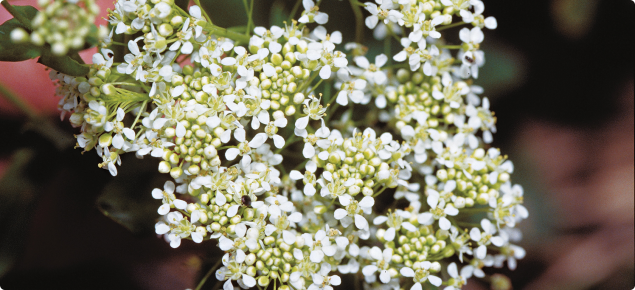What you should know about hoary cress
Hoary cress (Lepidium draba, formerly Cardaria draba) is also known as white weed and white top. Hoary cress is a member of the crucifer or cabbage family, Brassicaceae. It is a very competitive plant that can significantly reduce crop yields. It originated in the areas from the Mediterranean to central Asia and has become an important weed in eastern Australia, New Zealand, North America and South Africa. Several small infestations in the WA grainbelt are being targeted for eradication. Hoary cress is a declared plant for the whole of Western Australia.
Why hoary cress matters
The benign appearance of hoary cress belies its insidious nature. Hoary cress is a perennial plant with an extensive root system. It is a weed of grains, pastures and horticultural crops including orchards and vines. It is seldom grazed, but when stock is forced to eat the plant their milk and meat may become tainted. Hoary cress is a very difficult weed to eradicate. The chemicals that control it include hormone type herbicides and residual chemicals that are not suitable for use in many crops.
The roots of hoary cress release chemicals that hinder the growth of cereals (especially wheat) and horticultural crops including cabbage, onion and tomato. This is called allelopathy. Hoary cress also harbours pests and diseases which can spread to crops.
What you should look for
Hoary cress is an erect plant 15-75 centimetres high. It has branching stems and grey-green leaves covered in soft downy hairs. The hairs give it the whitish or 'hoary' appearance from which it gets it common name. The leaves are up to eight centimetres long, broadly oval in shape and distributed alternately up the stem.
The upper leaves have no leaf stalk. The flowers are small, about five millimetres across, and have four white petals. Numerous flowers appear from September to November, in clusters at the tops of the stems.
Life history of hoary cress
Hoary cress reproduces by seed and by means of its pervasive root system, which spreads laterally and down to a depth of two metres or more. Even very small pieces of the root cut off and moved by tillage machinery are capable of forming new plants. It also proliferates in minimum tillage systems. The seed is spread by stock and machinery and in grain. Seeds germinate in the autumn and form rosettes during the winter and spring. These usually die off in the first summer without flowering but the plant has by this time developed an extensive root system that carries it through until new rosettes form in the following autumn. Rosettes can be formed out of season if the root system is disturbed by cultivation.
The seeds of hoary cress are very small, about 0.5 millimetres long. They are produced in a heart shaped capsule at the base of the flower. Each plant can produce up to 5000 seeds, which are known to remain viable for at least three or four years.
Hoary cress is mainly a weed of cultivation, though it will also grow on roadsides and wasteland. In south-eastern Australia it occurs in cereal growing areas on a range of soil types but particularly on alkaline black and red clay loams. It is less common on sandy surfaced soils. In other countries it grows in a wide range of situations including citrus orchards in Spain, vineyards in Romania, cornfields in Iran and cereal crops, pastures, vegetables, vineyards, orchards and rangelands in the USA. Hoary cress could potentially cover large areas in the south-west of Western Australia and affect many crops.
Online weed identification training
Login or set up a new account on DAFWAs online training site to access:
- a training course on how to identify hoary cress and report it.
- training material that you can use to teach community groups how to identify hoary cress.
What you can do
Practice good biosecurity and avoid bringing any contaminated seed, machinery or livestock onto your property. Be vigilant and learn to identify the weeds on and around your property. Report suspect hoary cress or any other unusual weeds to the Pest and Disease Information Service. Samples can be submitted to AGWEST Plant Laboratories for identification.
Further information
For more information on hoary cress, search this website or contact the Pest and Disease Information Service.

